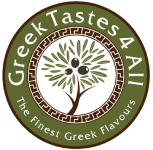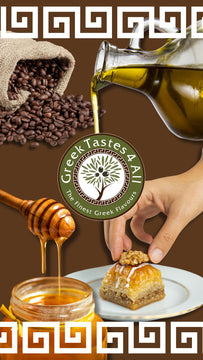Olive: The blessed Greek fruit
Olive: The blessed Greek fruit
Olive is the fruit of the olive tree, which is the symbol tree of the eastern Mediterranean countries. This small fruit contains a variety of beneficial nutrients, vitamins and minerals. Black olives vary from green olives in case of of maturity - Black olives are just green olives left on the tree for a longer period before harvest.
Olive tree is botanically called Olea europaea, belongs to the Oleaceae breed (oilseeds).
The history of the olive tree and its fruit is very old and inextricably linked to the people of the areas where it is cultivated, both nutritionally as well as commercially and culturally. In our everyday life we call the tree and the fruit of the same name: olive
Olives, after harvesting (manually by shaking down, by shaking with special machines, etc.), are cleaned and placed into bins to lose their bitterness. Then they are being preserved with salt, in brine, vinegar or oil.
Olive Varieties
There are many olive varieties all over the world. In our country the main varieties are:
- the Throumba of Crete (Variegated olives, in various sizes, harvested ripe from the tree)
- Kalamata olives (black, large, thick and usually oblong olives preserved in brine)
- The cracked (small green olives, preserved in brine)
- Amfissis’s olives (large black olives preserved in brine)
- the Cretan olives (small, black olives, preserved in brine)
- Kolymvades are being produced by olive which are not completely mature, and also preserved in brine with vinegar, covered with fennel
Each olive variety does not only differ in taste from each other but also in calories and nutrients and especially in the containing antioxidants and their effectiveness.
Olives are also being separated according to their size:
• Small fruited (ladoelies)
• Mesocarp or Middle fruited (Mytilene, Throumbolia, Megaritiki, etc.)
• Chondrolia or Big Olives (like Amfissis’s, from Agrinio, from Volos, Kalamata olives and others)

Olive’s ingredients & Health
Monounsaturated fatty acids: About 75% of olive’s fatty are classified as monounsaturated fats. The consumption of monounsaturated fatty acids is associated with decreased risk of cardiovascular diseases. When monounsaturated fatty acids replace saturated fat on diet, they reduce both total and LDL («bad") cholesterol in blood. Moreover, it appears that they help in increasing the HDL cholesterol ("good" cholesterol) when they replace the intake of carbohydrates on diet. Finally, it seems that they protect the LDL («bad" cholesterol) from oxidation, helping to prevent atherosclerosis.
Olive’s Antioxidants: Antioxidants are compounds that protect body cells from damages caused by free radicals. These molecules are very active, which may play a role in preventing cardiovascular diseases , help prevent some cancer forms, to prevent inflammation and also other diseases associated with aging. Olive’s antioxidant profile and the benefits it could provide, is less well known than that of olive oil. We know, however, that the variety, degree of ripeness and the way of storage of olives are factors that influence their formation in antioxidants. In general, black olives contain three to four times more phenolic compounds than green olives and therefore they showed higher antioxidant capacity in vitro studies.
The main phenolic compounds of both black and green olives are hydroxytyrosol and tyrosol. They increase olive’s oxidative stability and improve their flavor. Comparing the content of olives and olive oil in antioxidants (weight equivalent) we find that olives (depending on the variety, ripening and storage), contain four to ten times more hydroxytyrosol than olive oil.
Vitamins and Minerals
| AVERAGE NUTRITIONAL ANALYSIS 100g VARIOUS VARIETIES OF OLIVES | ||||||
| Nutrinional information | Measurement of Units | Kalamata olives | Organic Kalamata Olives | Black Cretan Stafidoelies | Cretan Green Cracked Olives | Green Olive from Chalkidiki |
| Proteins | g | 1,5 | 1,6 | 1,9 | 2,1 | 1,1 |
| Carbohydrates | g | 0,2 | 0,3 | 0,2 | 0,1 | 0,1 |
| Total fat | g | 21,9 | 25,2 | 42,7 | 34,6 | 18,4 |
| Water | g | 68 | 62,5 | 33,1 | 49,1 | 71,5 |
| Dietary fibers | g | - | - | - | - | - |
| Vitamin Α | mg | - | - | - | 200 | 200 |
| Calcium | mg | 71 | 89 | 76 | 59 | 94 |
| Potassium | mg | 152 | 79 | - | - | 91 |
| Magnesium | mg | 52 | 56 | 113 | 77 | 55 |
| Sodium | mg | 577 | 787 | - | - | 651 |
| Iron | mg | 2,7 | 5,2 | 6,9 | - | 5 |
| Phosphorus | mg | 248 | 380 | 352 | 322 | 260 |
| Selenium | mg | - | - | - | 4,7 | - |
| Chromium | mg | 2,3 | 13,5 | - | - | - |
Selection and Conservation
Olives are best to be purchased after testing and in quantities that meet our needs for a maximum of two weeks. Stuffed olives are more sensitive. At home they have to be preserved in glass containers with a dilute of vinegar or brine. Covering the olives with a layer of oil to effectively protects them against rancidity and mildew (mold). Canned stuffed olives have to be preserved in the refrigerator after opening. Particular importance has the possible attack by insects or fungi (mold) and the high content in salt.
Olives are being consumed in several ways, all over Greece. They can be eaten as an appetizer or as an accompanying (with beans, sardines and various types of cheese), but also included in many salads. They are also used in cooking as an ingredient in sauces and in foods, pies etc.
Xenaki Dimitra, PhD in Molecular & Structural Chemistry of Foods
Stergiou Margarita, Dietician – Nutritionist, M.Sc










